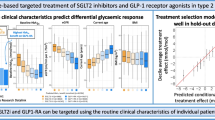Abstract
Summary
Our network meta-analysis analyzed the effects of glucagon-like peptide-1 receptor agonists (GLP-1 RAs) on fracture risk. By combining data from randomized controlled trials, we found that GLP-1 RAs were associated with a decreased bone fracture risk, and exenatide is the best option agent with regard to the risk of fracture. This study is registered with PROSPERO (CRD42018094433).
Introduction
Data on the effects of GLP-1 RAs on fracture risk are conflicted. This study aimed to analyze the available evidence on the effects of GLP-1 RAs on fracture risk in type 2 diabetes mellitus patients.
Methods
Electronic databases were searched for relevant published articles, and unpublished studies presented at ClinicalTrials.gov were searched for relevant clinical data. All analyses were performed with STATA 12.0 and R software (Version 3.4.4). We estimated the risk ratio (RR) and 95% confidence interval (CI) by combining RRs for fracture effects of included trials.
Results
There were 54 eligible random control trials (RCTs) with 49,602 participants, including 28,353 patients treated with GLP-1 RAs. Relative to placebo, exenatide (RR, 0.17; 95% CI 0.03–0.67) was associated with lowest risk of fracture among other GLP-1 RAs. Exenatide had the highest probability to be the safest option with regard to the risk of fracture (0.07 ‰), followed by dulaglutide (1.04%), liraglutide (1.39%), albiglutide (5.61%), lixisenatide (8.07%), and semaglutide (18.72%). A statistically significant inconsistency was observed in some comparisons.
Conclusion
The Bayesian network meta-analysis suggests that GLP-1 RAs were associated with a decreased bone fracture risk compared to users of placebo or other anti-hyperglycemic drugs in type 2 diabetes mellitus patients, and exenatide is the best option agent with regard to the risk of fracture.



Similar content being viewed by others
References
Unnikrishnan R, Mohan V (2016) Diabetes in the tropics: prevalent, increasing and a major public health problem. Trans R Soc Trop Med Hyg 110:263–264
Drucker DJ (2018) Mechanisms of action and therapeutic application of glucagon-like peptide-1. Cell Metab 27:740–756
Gallwitz B (2015) GLP-1 receptor agonists in type 2 diabetes and beyond - new insights 2015. Eur Endocrinol 11:21–25
Mabilleau G, Gobron B, Bouvard B, Chappard D (2018) Incretin-based therapy for the treatment of bone fragility in diabetes mellitus. Peptides 100:108–113
Goldshtein I, Nguyen AM, DePapp AE, Ish-Shalom S, Chandler JM, Chodick G, Shalev V (2018) Epidemiology and correlates of osteoporotic fractures among type 2 diabetic patients. Arch Osteoporos 13:15
Epstein S, Defeudis G, Manfrini S, Napoli N, Pozzilli P (2016) Diabetes and disordered bone metabolism (diabetic osteodystrophy): time for recognition. Osteoporos Int 27:1931–1951
de Liefde II, van der Klift M, de Laet CE, van Daele PL, Hofman A, Pols HA (2005) Bone mineral density and fracture risk in type-2 diabetes mellitus: the Rotterdam Study. Osteoporos Int 16:1713–1720
Schwartz AV, Vittinghoff E, Bauer DC, Hillier TA, Strotmeyer ES, Ensrud KE, Donaldson MG, Cauley JA, Harris TB, Koster A, Womack CR, Palermo L, Black DM (2011) Association of BMD and FRAX score with risk of fracture in older adults with type 2 diabetes. JAMA 305:2184–2192
Faltinsen EG, Storebo OJ, Jakobsen JC, Boesen K, Lange T, Gluud C (2018) Network meta-analysis: the highest level of medical evidence? BMJ Evid Based Med 23:56–59
Higgins JP, Altman DG, Gotzsche PC, Juni P, Moher D, Oxman AD, Savovic J, Schulz KF, Weeks L, Sterne JA (2011) The Cochrane Collaboration’s tool for assessing risk of bias in randomised trials. BMJ 343:d5928
Dias S, Sutton AJ, Ades AE, Welton NJ (2013) Evidence synthesis for decision making 2: a generalized linear modeling framework for pairwise and network meta-analysis of randomized controlled trials. Med Decis Mak 33:607–617
Mills EJ, Thorlund K, Ioannidis JP (2013) Demystifying trial networks and network meta-analysis. BMJ 346:f2914
Mawdsley D, Bennetts M, Dias S, Boucher M, Welton NJ (2016) Model-based network meta-analysis: a framework for evidence synthesis of clinical trial data. CPT Pharmacometrics Syst Pharmacol 5:393–401
Dias S, Welton NJ, Caldwell DM, Ades AE (2010) Checking consistency in mixed treatment comparison meta-analysis. Stat Med 29:932–944
Cooper NJ, Sutton AJ, Lu G, Khunti K (2006) Mixed comparison of stroke prevention treatments in individuals with nonrheumatic atrial fibrillation. Arch Intern Med 166:1269–1275
van Valkenhoef G, Dias S, Ades AE, Welton NJ (2016) Automated generation of node-splitting models for assessment of inconsistency in network meta-analysis. Res Synth Methods 7:80–93
Dias S, Sutton AJ, Welton NJ, Ades AE (2013) Evidence synthesis for decision making 3: heterogeneity--subgroups, meta-regression, bias, and bias-adjustment. Med Decis Mak 33:618–640
Chaimani A, Higgins JP, Mavridis D, Spyridonos P, Salanti G (2013) Graphical tools for network meta-analysis in STATA. PLoS One 8:e76654
Stroup DF, Berlin JA, Morton SC, Olkin I, Williamson GD, Rennie D, Moher D, Becker BJ, Sipe TA, Thacker SB (2000) Meta-analysis of observational studies in epidemiology: a proposal for reporting. Meta-analysis Of Observational Studies in Epidemiology (MOOSE) group. JAMA 283:2008–2012
Mabilleau G, Mieczkowska A, Chappard D (2014) Use of glucagon-like peptide-1 receptor agonists and bone fractures: a meta-analysis of randomized clinical trials. J Diabetes 6:260–266
Su B, Sheng H, Zhang M, Bu L, Yang P, Li L, Li F, Sheng C, Han Y, Qu S, Wang J (2015) Risk of bone fractures associated with glucagon-like peptide-1 receptor agonists' treatment: a meta-analysis of randomized controlled trials. Endocrine 48:107–115
Zeng I, Lumley T (2018) Review of statistical learning methods in integrated omics studies (an integrated information science). Bioinf Biol Insights 12:1216874372
Gunhan BK, Friede T, Held L (2017) A design-by-treatment interaction model for network meta-analysis and meta-regression with integrated nested Laplace approximations. Res Synth Methods 9:179–194
Funding
The present study was supported by grants from the National Natural Science Foundation of China (grant no. 81774344).
Author information
Authors and Affiliations
Corresponding author
Ethics declarations
Conflicts of interest
None.
Electronic supplementary material
ESM 1
(DOCX 36 kb)
Rights and permissions
About this article
Cite this article
Zhang, Y.S., Weng, W.Y., Xie, B.C. et al. Glucagon-like peptide-1 receptor agonists and fracture risk: a network meta-analysis of randomized clinical trials. Osteoporos Int 29, 2639–2644 (2018). https://doi.org/10.1007/s00198-018-4649-8
Received:
Accepted:
Published:
Issue Date:
DOI: https://doi.org/10.1007/s00198-018-4649-8




